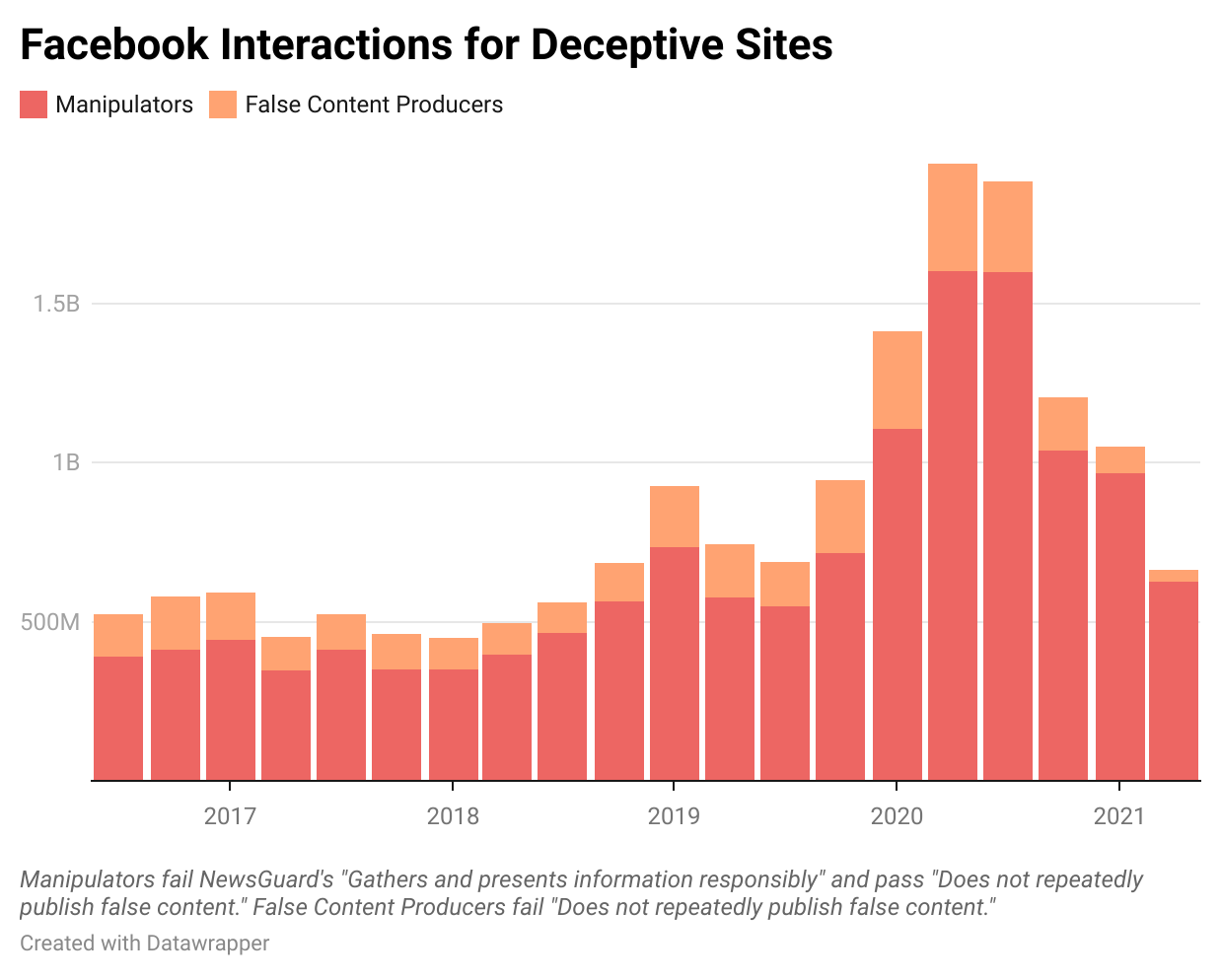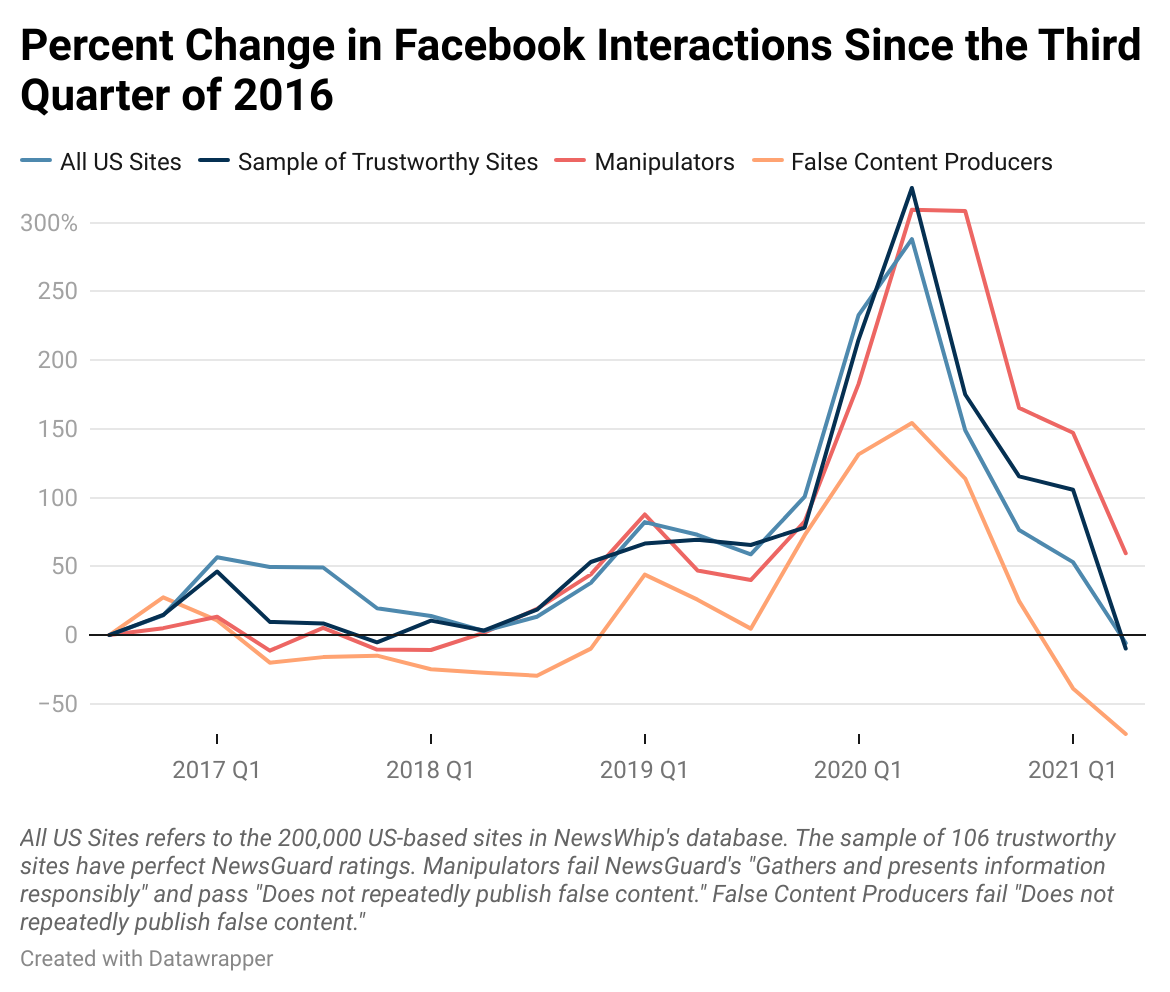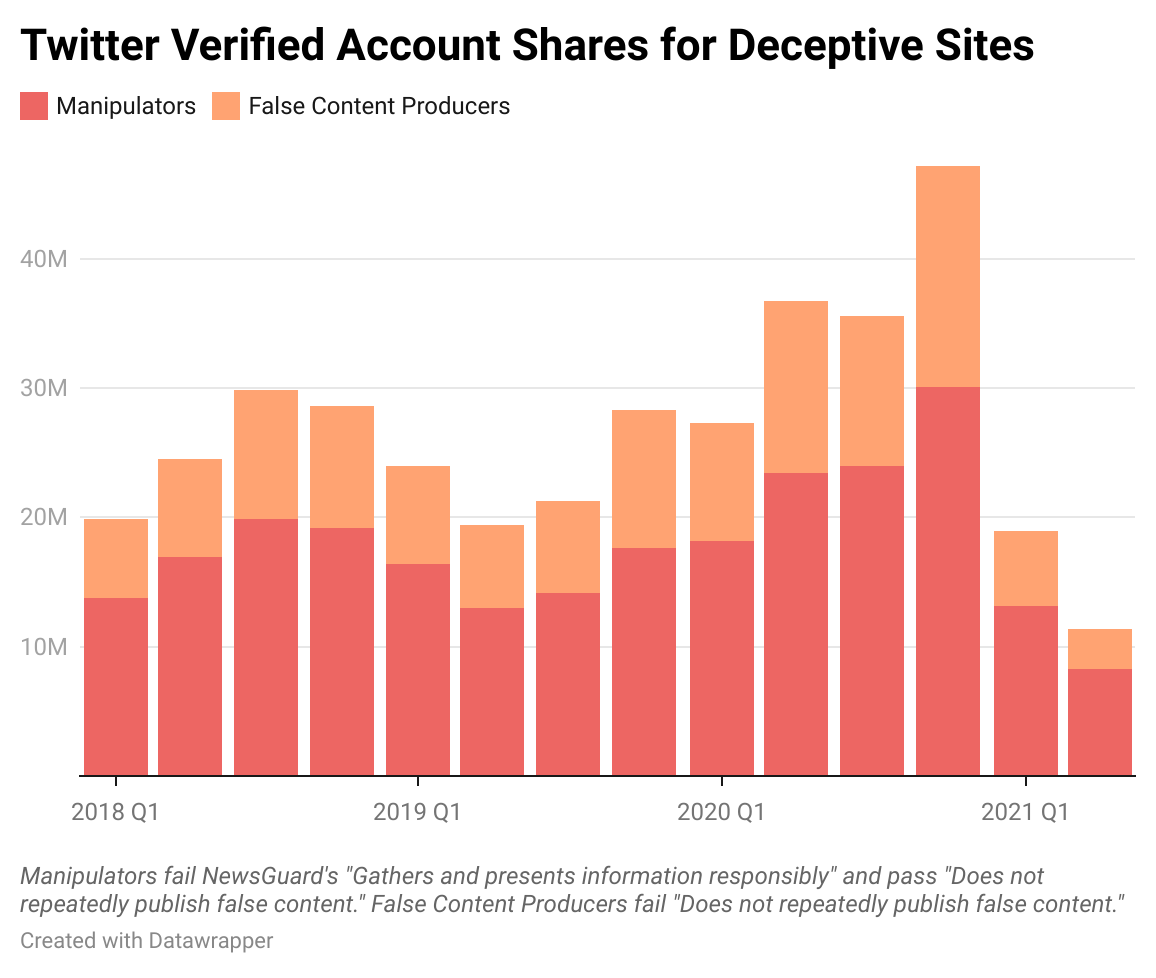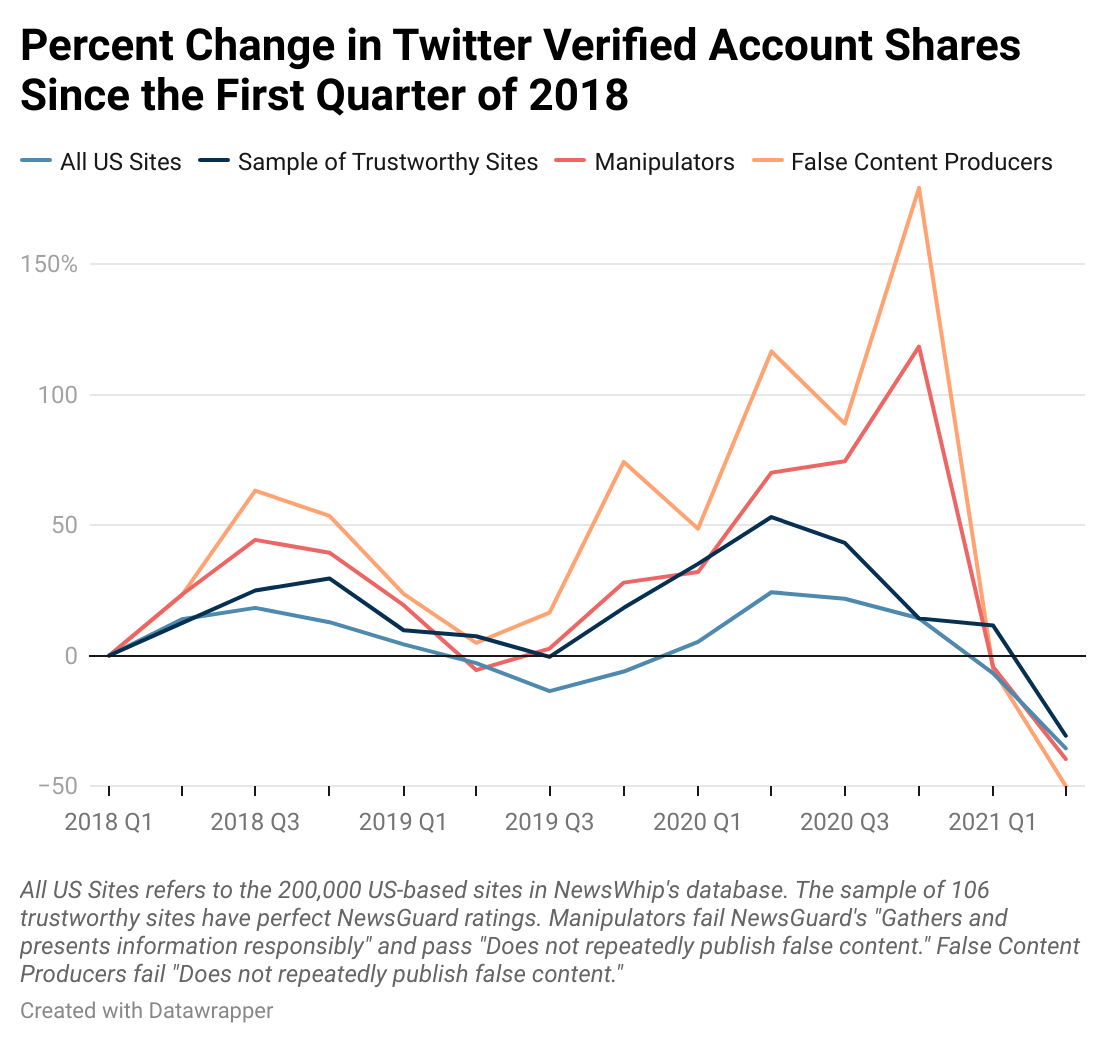Engagement with False Content Producers Plummeted on Twitter and Facebook
Sites that gather and present information irresponsibly (according to the news-rating service NewsGuard) accounted for a record-high one-fifth of Facebook interactions with U.S.-based sites1 in the second quarter of 2021, while engagement with articles from outlets that repeatedly publish false content plummeted on Twitter and Facebook. This occurred amidst an overall decline in engagement with all types of sites. After all-time highs in engagement with both types of deceptive news outlets in 2020, sites that publish false content have seen their engagement drop at much higher rates than U.S.-based sites in general, likely as a result of account takedowns and changes in policies around COVID-19 misinformation and content moderation.
The changes demonstrate that Facebook and Twitter have the tools to address disinformation. However, outlets that gather and present information irresponsibly without publishing false content present a special challenge to the platforms. These sites can help spread conspiracies theories about elections and vaccines, highlighting the need for what GMF Digital calls “democratic design” principles to promote transparency and civic information.
-
Amidst an overall decline in Facebook interactions with U.S.-based sites that began in the latter half of 2020, interactions with outlets that collect and present information irresponsibly dropped in the second quarter of 2021. They fell by slightly less than the drop in overall traffic (35 percent vs 38 percent) and by far less than a sample of 106 trustworthy sites with perfect NewsGuard ratings (56 percent) or sites that repeatedly publish false content (54 percent). Sites that gather and present information irresponsibly can help spread conspiracy theories without publishing false content by cherry-picking anecdotes.
-
As a result, outlets that gather and present information irresponsibly saw their share of interactions with all U.S.-based sites increase to over one-fifth, a five-year high, while false content producers accounted for only 1 percent of interactions—a five-year low.
-
On Twitter, verified account shares with sites that repeatedly publish false information fell by 47 percent, outpacing the decline in shares with sites that gather and present information irresponsibly (37 percent), trustworthy sites (38 percent), and all types of web content (31 percent). Sites that gather and present information irresponsibly made up 9 percent of verified account shares of links to U.S.-based sites, and those that repeatedly publish false content made up 3 percent of shares. These are three-year lows for both types of outlet.
-
The best-performing content on Facebook from outlets that gather and present information irresponsibly focused on race and culture-war issues like critical race theory, but the top-performing articles on each platform raising questions on vaccines also came from these outlets. These outlets dominated outlet traffic on Facebook.
Note: For Facebook, GMF’s Digital New Deal project measures interactions (likes, comments, and shares) on posts that include links to deceptive sites—sites that repeatedly publish false content or gather and present information irresponsibly. For Twitter, we analyze shares (tweets and retweets) by verified accounts (that is, blue check-marks) of links to deceptive sites. Facebook interactions and Twitter verified account shares of articles are just a piece of the misinformation puzzle. On Facebook, private groups, memes, and even profile picture frames are also vectors of misinformation. On Twitter, verified accounts represent a small subset of the user base. Interactions and verified account shares do not reflect the number of people who have seen a given piece of content.
Interactions with false and manipulative sites continued to drop in the second quarter of 2021, with sites that publish false content below their 2016 levels and manipulative sites above them. Amidst an overall drop in interactions with U.S.-based sites, interactions with false-content producers and trustworthy sites dropped by over half between the first two quarters of 2021 while interactions with sites that gather and present information irresponsibly dropped by less (slightly more than a third).

Interactions with all types of web content, including both kinds of deceptive outlets, increased steadily from the third quarter of 2016 through 2019, before a dramatic uptick 2020. Interactions declined beginning in the third quarter of 2020, with a more intense drop beginning in February 2021. Interactions for outlets that gather and present information irresponsibly grew by 309 percent from the run-up to the 2016 presidential election through the second quarter of 2020, but by second quarter of 2021 they had only increased by 59 percent relative to 2016 levels. Meanwhile, interactions with outlets that repeatedly publish false content declined by 72 percent from 2016 through the second quarter of 2021. Just one year earlier, in the second quarter of 2020, interactions with false content producers had increased by 154 percent relative to 2016 levels. Interactions for all U.S.-based sites and the sample of trustworthy sites were roughly the same in the second quarter of 2021 as in 2016, after having grown considerably in 2020.

The top five manipulative sites (Daily Wire, Fox News, The Blaze, Breitbart, and Bongino) accounted for two-thirds of interactions with such sites. There was some movement among these top outlets: The Daily Wire became the top outlet in 2021 after four years of Fox News dominance. The Conservative Opinion dropped out the top five in the second quarter of 2021 as its interactions fell from 61 million to 15 million.
According to NewsGuard, outlets that gather and present information irresponsibly fail to “reference multiple sources, preferably those that present direct, firsthand information on a subject or event or from credible second-hand news sources.” These outlets “egregiously distort or misrepresent information to make an argument or report on a subject.” Below are some of the highest-performing articles about vaccines from this group of outlets.
- Daily Wire: “NFL Wide Receiver Refuses Vaccine, Wants To 'Represent' Other Silent Players: 'If I'm Forced Into Retirement, So Be It.'” 284,000 interactions.
- Fox Business: “Florida Gov. Ron DeSantis signs executive order banning 'vaccine passports.’” 207,000 interactions.
- Washington Times: “Rep. Marjorie Taylor Greene proposes bills to fire Dr. Fauci, ban vaccine passports.” 126,000 interactions.
These types of articles speak to the challenges that outlets that gather and present information irresponsibly pose to Facebook. The articles do not include falsehoods about vaccines. But they disproportionately amplify vaccine-hesitant voices over experts and safety data and fail to mention risks of not being vaccinated against COVID-19. This is where what GMF Digital calls “democratic design” would help by increasing transparency on coordination, amplification, and outlet funding and practices, while amplifying civic information providers such as public-health officials.
Various new Facebook policies that address upstream design may have restricted interactions with false content producer content.
-
Facebook began reducing the distribution of posts in News Feed from an individual’s Facebook account if they repeatedly share false content. Our data do not include interactions on posts from private profiles, but individuals can boost public pages by sharing their content.
-
Facebook began displaying a pop-up when users attempt to like a page that has repeatedly published false content.
-
In June, Facebook stopped automatically applying the “newsworthiness” fact-checking exception to politicians.
-
In May, Facebook banned the page for LifeSiteNews, an anti-abortion false content producer, over COVID-19 and vaccine misinformation policies. LifeSiteNews.com was one of the top false content producers in 2019 and 2020.
Not all Facebook policy changes have a significant observable impact on outlet interactions. For example, interactions with the sample of trustworthy sites did not increase dramatically when Facebook emphasized the quality of journalism in its news feed algorithm in immediate aftermath of the 2020 presidential election. However, the changes may have increased views of content from trustworthy outlets or prevented a significant decline in engagement with trustworthy sites.
Verified account shares of links to false content producers fell by 47 percent between the first and second quarters of 2021, significantly more than shares of links to all U.S. sites (35 percent), outlets that gather and present information irresponsibly (37 percent), and trustworthy outlets (38 percent). These declines in shares for outlets that produce false or misleading content come after historic highs in the fourth quarter of 2020.

Compared to 2018, when our data set begins, verified account shares of links to deceptive sites declined even more than shares with all types of U.S.-based sites, with false content producers experiencing the greatest decline. The drop-off was even more pronounced compared to the fourth quarter of 2020, when shares with false and misleading outlets reached their peak. Relative to the first quarter of 2018, verified account shares dropped by 50 percent for outlets that repeatedly publish false information, after having grown by 179 percent through the fourth quarter of 2020. For outlets that gather and present information irresponsibly, verified account shares decreased 40 percent relative to 2018 levels after having increased 118 percent at the end of 2020. Neither the sample of trustworthy sites nor all U.S.-based sites had extreme increases in verified account shares during 2020, but both types of outlets had smaller declines in 2021 than the deceptive sites. Compared to 2018, verified account shares declined 31 percent for the sample of trustworthy sites and 36 percent for all U.S.-based outlets.

The top five manipulative sites (Fox News, Breitbart, Hannity, Post Millennial, and Epoch Times) were responsible for half of manipulative site verified account shares. The second quarter of 2021 was the first time since 2018 in which no site that repeatedly publishes false content had verified account shares equivalent to the top five manipulative sites, as The Gateway Pundit and The Federalist had significant declines in their verified account shares.
Although Twitter announced more vigorous policies towards COVID-19 misinformation during the first and second quarters of 2021, some anti-vaccine content still performed well on the platform.
-
Children’s Health Defense, the site associated with “Disinformation Dozen” member Robert F. Kennedy Jr., increased its verified account shares by 34 percent between the first and second quarters of 2021, reaching its highest quarterly levels of shares ever.
-
Zero Hedge became the top false content producer, thanks in part to its high-performing COVID-19 misinformation. The site’s second-most popular article of the quarter, “Caught Red-Handed: CDC Changes Test Thresholds to Virtually Eliminate New COVID Cases Among Vaxx'd,” received 6,953 verified account shares.
Twitter policy actions continued to impact deceptive site verified accounts shares.
-
Twitter design changes included the deployment of automated tools to help label tweets that contain misleading information around COVID-19 vaccinations, a “five strikes and you’re out” COVID-19 disinformation policy announced in March, and account suspensions of anti-vaccine advocate Naomi Wolf and Project Veritas founder James O’Keefe.
-
The second quarter of 2021 marked the first complete quarter in which the accounts for Donald Trump, Lin Wood, and Jim Hoft (editor-in-chief of the Gateway Pundit), among others, were not on Twitter. Hoft’s account drove shares of links to the Gateway Pundit, helping it receive 7.2 million verified account shares in the fourth quarter of 2020. In the second quarter of 2021, the Gateway Pundit received 312,000 verified account shares.
- 1All U.S.-based sites refers to the over 200,000 sites that NewsWhip, a social-media intelligence firm, tracks. This includes news sites, sites for companies such as Nike or McDonalds, e-commerce sites such as Amazon or Etsy, or publishing platforms such as Medium.
